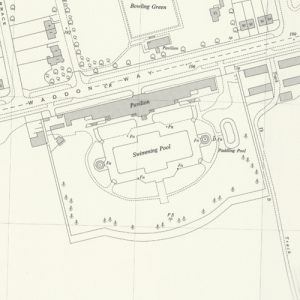
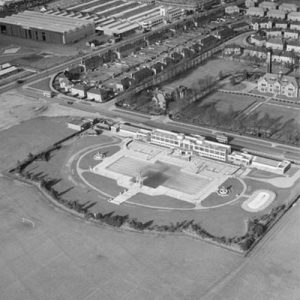
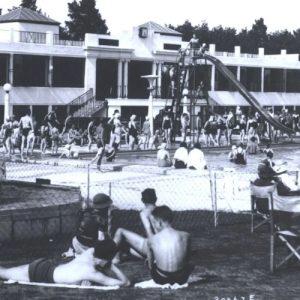
A London pool that was one of very few that could compete with the size and spectacle of the seaside stadiums such as South Shore at Blackpool, Morecambe and Heysham or New Brighton. These pools, and Purley were destinations of not only swimming but of other forms of entertainment and fitness. London already had Tooting Bec and Whipps Cross, both larger pools but altogether more utilitarian with less land.
The pool was built in an area of modern design and close to Croydon Airport. The impressive façade of two storeys and roof terrace dominated Waddon Way at over 200m long.
The council were happy to spend money on improvements, spending £575 at the end of the first season and a further £570 in 1937 for the iconic diving board.
The pool was a great success and covered its operating costs of £5,625 during 1937-1938.
Post-war, the council spent a further £6,729 on additional dressing accommodation and café.
The pool featured significant lighting in and around the pool leading to its nickname of “The Electric Pool.”
The pool had a major innovation being the sterilisation of the water by use of ozone. Ozone also led to the refreshing atmosphere surrounding the pool as it was fed through jets in the pool floor. It gave the water a blue tint. The ozone plant would go on to be installed in other pools around the country.
The pool lasted until 1979 when faced with mounting maintenance and repair costs, it was closed at the end of that summer.
The site became a garden centre, which changed hands a number of times before finally closing in 2019. Parts of the original main block on Waddon Way were used but it was tragically truncated by a barbarian.
The site was purchased by Bellway Homes but after a number of years battling with the local authority for permission to build flats with the diving stage as a feature, they have no plans to resubmit.
The concrete diving stage remains surrounded by debris and probably not being properly maintained.
| Name | Purley Way Open-Air Bathing Pool Waddon Way, Croydon, London, CR9 4HY, England |
| Coordinates | 51°21’27.8″N 0°06’50.5″W |
| Built / opened | 20th July 1935 by the Mayor of Croydon, Alderman J. Trumble, J.P. |
| Cost | £15,600 |
| Dimensions | Cruciform shape 200′ x 70′ on major axis 100′ c 60′ on minor axis |
| Water volume | 650,000 gallons |
| Water type | Heated fresh water sterilised with ozone |
| Depth(s) | Central diving pit 6′ 6″ to 15′ |
| Diving | Iconic listed diving board aded in 1937 at a cost of £476. Reinforced concrete structure installed by Grays Ferro-Concrete Co Ltd. |
| Changing facilities | |
| Second pool | N/A |
| Spectator seating | |
| Designer | Mr. C. E. Boast, M.C., M.Inst.C.E., F.S.I., Borough Engineer and his architectural assistant, Mr. F. J. Williams, |
| Date closed | Late 1979 |
| Status | Infilled, some pool buildings remain |
| On site now | Derelict garden centre, derelict remains of pool buildings, listed diving board |
| Last updated | 31st August 2025 |

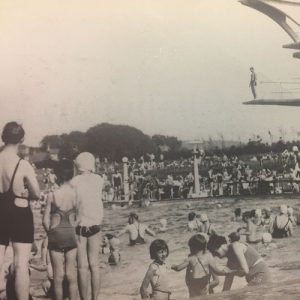
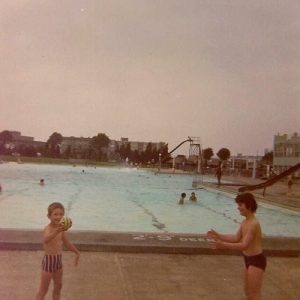
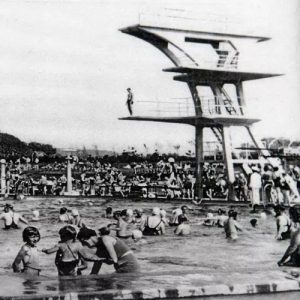
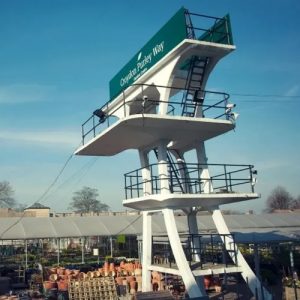
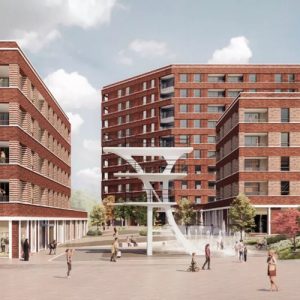
Baths and Bath Engineering August 1935
Purley Way Open-Air Bathing Pool, Croydon.
STERILISATION BY OZONE.
The pool which is situated on part of the Purley Way Playing Fields near the junction of Purley Way and Waddon Way, opposite the Croydon Aerodrome, was opened on July 20 by the Mayor of Croydon (Ald. J. Trumble, J.P.).
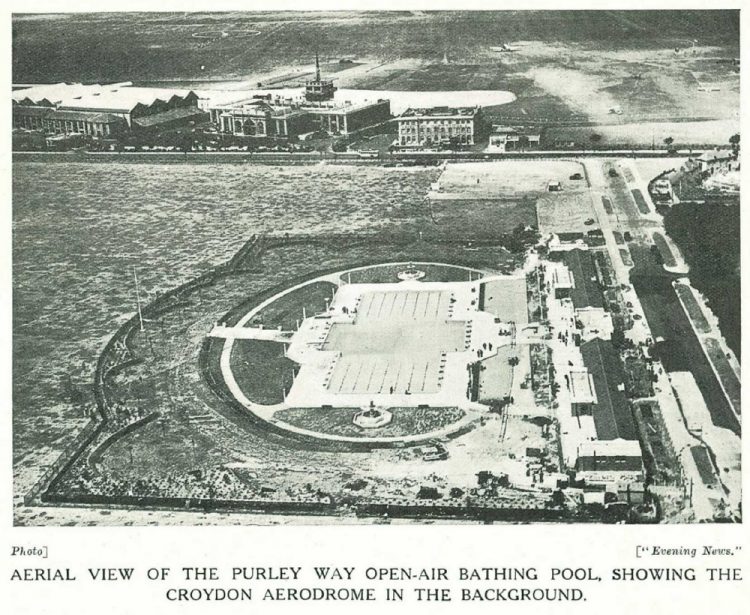
The site, which contains about 4 acres, rises slightly to the south, and in view of this the pool and its surrounds have been excavated to form a sunken area, which enables spectators to view the whole pool from the southern side.
The pool is constructed of reinforced concrete and is cruciform in shape, with shallow areas at each end.
It is 200 ft. by 70 ft. on its major axis and 100 ft. by 60 ft. on its minor axis. The deep-water area is the centre of the pool, the depth being 15 ft. at one side and 6 ft. 6 in. at the other. This complies with all international requirements for polo, racing, and diving.
The sides and floor of the pool are finished with ” Snowcrete ” to a smooth surface. White glazed scum channelling extends round the whole of the pool. Four flights of concrete steps are provided in the shallow ends, and four flights of vertical metal steps in the deeper water.
Provision has been made for 36 underwater floodlighting chambers, each taking 1,000-watt lamp fittings.
There is a green curb surrounding the pool, 3 ft. wide, which is raised above the buff concrete margin by a few inches to assist in preventing contamination.
At each end of the pool are cascades in polished green artificial stone, which can be used if necessary for aerating the pool water. Around the stems of these cascades are formed lanterns for colour changing illumination.
Ample provision has been made in the lay-out for sunbathing beaches, formed of shingle, suitably under drained so that they can be properly washed and sterilised.
The grounds are laid out in shrubberies, flower beds, and lawns, and surrounded by a raised shrubbery embankment.
In addition to the underwater floodlighting and cascades, a colour changing fountain on the main terrace is provided. ‘ Snowcrete ” standard lamps illuminate the surrounds of the pool, and festoon lighting forms a special feature in the shrubberies and flower borders.
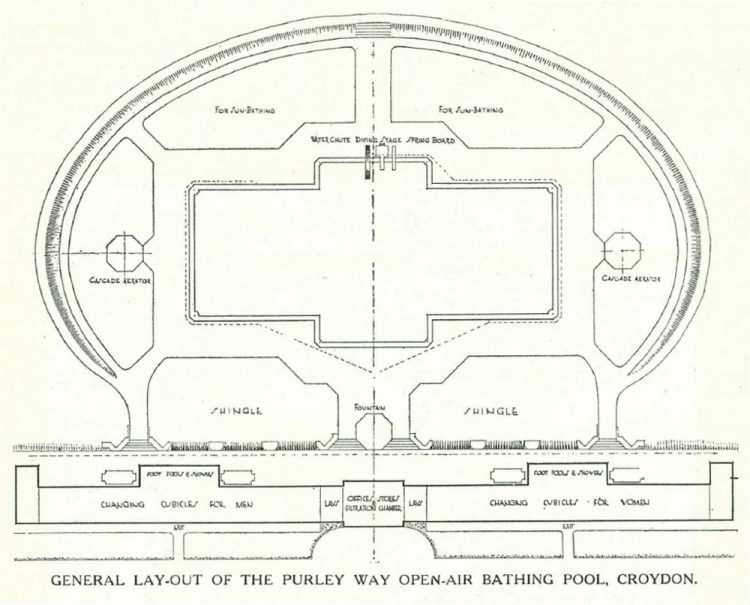
Purification Plant.
The filter plant at this pool has been installed by Messrs. “Turn-Over” Filter Co., Ltd., of Belfast and London, and consists of nine vertical filters, contained in two shells which take up a very small space, when it is considered that they are clarifying the water at over 100,000 gal. per hour.
The water is drawn from the deep part of the pool by means of a centrifugal pump, discharged through the filters, and returned to the shallow ends of the pool, a part of the flow being cascaded over an aerator, the total contents of the pool are turned over every six hours. A duplicate pumping set is provided as a standby.
The special design of the filter enables the filtering media to be of one fine uniform grade from top to bottom of the filter beds which are tightly packed between conical shaped plates. With this design the filtration speed is 450 to 500 gal. per sq. ft. per hour.
In washing the filter, the sand is injected from the bottom of one section into the top of an adjoining empty section, there being provided in the first case one empty section in the battery. When the beds are turned over from one section to another, the sand is thoroughly broken up and all impurities removed.
Another interesting item in the filter room is a high-tension electrode boiler of Messrs. Sulzer’s manufacture, which was installed under the contract of Messrs. Bruce H. Auld and Co.
This is one of the very few large open-air baths in· this country where an electric heating plant is installed. The boiler has a capacity of 750 kw. and takes up little floor space. The boiler is fed from the H.T. mains and incorporates automatic devices for maintaining the temperature of the water in the pool at a comfortable level.
Another particularly interesting feature is the ” S.A.” ozone treating plant, manufactured and installed by Messrs. Bruce H. Auld and Co., of London. This plant is used for sterilising the water in the pool and is claimed to be the first of its kind to be installed in this country in connection with a large open-air public swimming pool. There is a refreshing atmosphere around the pool, and the bathers appreciate the energising and tonic effects of the ozone. The water produced is of attractive bluish appearance, and owing to the oxidising properties of ozone, a very clear and fully aerated water is produced.
The ozone generators are housed in a separate room, and connections are taken to the main water delivery from the filter plant to ensure that the water is sterilised prior to entering the pool, and in addition, by means of an air blower, ozone is fed through jets in the pool floor, ensuring an even distribution throughout the pool.
The buildings, situate on the north side of the pool comprise a central administrative block, with changing cubicles, lavatories, and lockers on either side.
The filtration and heating chamber occupies the basement in the main block.
The lay-out provides for the erection on the western side at some future time, of a restaurant, to serve the bathing pool and the playing fields.
The pool has been designed and carried out under the general direction of the borough engineer, Mr. C. E. Boast, M.C., M.Inst.C.E., F.S.I., and his architectural assistant, Mr. F. J. Williams, and the electrical work in connection therewith by Mr. F. N. Rendell Baker, A.M.I.E.E., chief engineer and general manager of the electricity department.
The manager of the pool is Comdr. R.R. Devlin, R.N. (retired).
Contractors.
Among the contractors who were employed on the construction of the pool were the following:
- General contractor, Messrs. Perrys (Ealing), Ltd., 75 Uxbridge-road, W5
- Filtration, Messrs. Turn-Over Filter Co., 66 Victoria-street, SW1
- Boiler, sterilisation and aeration, Bruce H. Auld and Co., 66 Victoria-street, SW1
- Diving equipment, Messrs. T. M. Gardiner, Ltd., Hoddesdon, Herts
- Reinforced concrete engineers, Indented Bar and Concrete Engineering Co., Ltd., Vincent House, Vincent-square, SW1.
- Steel lockers, Messrs. Constructors, Ltd., Tyburn-road Erdington, Birmingham
- Foot sprays and shower fittings, Messrs. Dent and Hellyer, Ltd., 35 Red Lion Square, WC1
- Floodlighting, Messrs. Holophane, Ltd., Holophane House, Elverton-street, SW1
The illustration at the head of this article shows the bathing pool at night with the floodlighting installation of Messrs. Holophane, Ltd., of London. Thirty-six 1,000-watt under-water floodlighting chambers are constructed in the walk around the pool, and the units are reached by a detachable square slab which is flush with the concrete walk. Special under-water units are fitted in these compartments equipped with 1,000-watt lamps.
The aerator fountains at the ends are equipped with colour changing lighting by the Holophane Auto-Control system. These fountains are continuously changing in colour contrast with the colour lighting in the base of the lily fittings which are shown on the side.
Baths and Bath Engineering November 1935
Croydon.
The borough council is recommended to carry out certain improvements at the Purley- way bathing pool, Croydon, at an estimated cost of £575. The bathing pool was described in our August 1935 issue.
Baths and Bath Engineering December 1936
Croydon
The county borough council have agreed to the expenditure of £570 on the provision of a high diving stage at the Purley Way swimming pool. The tender of the Grays Ferro-Concrete Co., Ltd. to construct the stage in reinforced concrete has been accepted at £476. It is stated that £94 will be spent by the council on foundations, paving and similar work.
Baths and Bath Engineering January 1937
Croydon
The borough council have accepted the tender of Messrs. E. S. Moss, Ltd., of Hendon, to erect a cafe and additional dressing accommodation at the Purley Way open-air bathing pool, at a cost of £6,729.
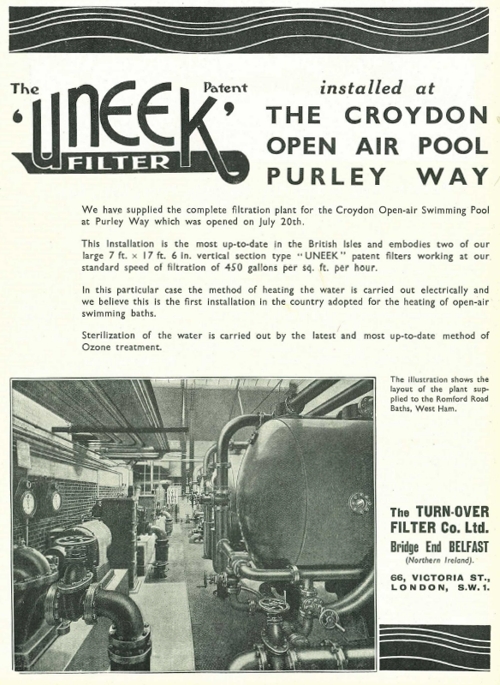
![]()